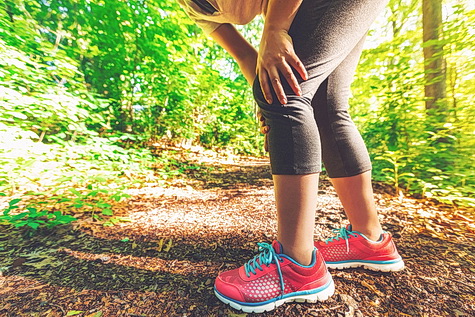
Osteoarthritis
Osteoarthritis (OA) is a commonly occurring chronic joint condition that is a progressive disease, which means that it gets worse with time. It’s also known as degenerative joint disease, degenerative arthritis, wear-and-tear arthritis.
When two bones come together at a point, they form a joint. The end of each bone is covered with a protective tissue known as cartilage, similar to oil in a car engine, acting as a buffer between the bones. People who suffer from OA have worn out cartilages, which allows the bones to rub against each other. This results in pain, inflammation and stiffness in the joints. It can lead to a slow breakdown of the joints as well.
Older people are usually the ones who suffer from this condition; however, adults of any age can have this condition. Although there’s no cure, regular treatments can be quite useful to reduce the pain and swelling and help a person stay active and mobile.
Causes
OA mostly occurs when the body fails to repair the cartilage. The joint is damaged over time, which is why age is a major contributing cause of OA. As people in the old age have joints that have undergone more wear and tear.
At times, genetics can also play a role in the increased risk of the development of this condition. In case the condition is hereditary, even people who are just 20 years old can be victims of OA.
The condition can also occur as a result of a traumatic injury, surgery or overuse of the joints due to certain jobs and sports that require repetitive movements. As this doesn’t allow the body to carry out regular repairs, it eventually leads to OA. It might take years after an injury for the symptoms to be evident.
Some other diseases and conditions that increase the chances of developing OA are inflammatory arthritis, septic arthritis, Paget’s disease, obesity, poor posture, misalignment of the hip, knee, and ankle, unequal length of the legs, or by birth joint and cartilage abnormalities.
Gender is also among the risk factors, where females are more likely to suffer from OA as compared to males.
Symptoms
OA can occur in any joint of the body, but it typically occurs in the hand, fingertips, spine, hips, and knees. A person suffering from an early stage of OA may not experience any symptoms. They may appear gradually, and the condition might cause pain, stiffness or inflammation in one or more joints.
As the condition develops, the pain and stiffness also intensify due to limited movements of the joint. In addition, swelling, loss of muscle bulk, warmth and tenderness, and difficulty in movement of the joint may occur. You might also observe a grating or crackling sound in the joint, known as crepitus.
It may also cause synovitis – a mild inflammation of the tissue surrounding the joint, damage and loss of cartilage, and bone spurs or osteophytes – bony growths that form around the edges of joints.
The condition can be managed more effectively if the symptoms are diagnosed at an early stage of OA.
Diagnosis
As OA usually develops over time, it can be quite difficult to diagnose it, unless the pain or impairing symptoms appear. The doctor asks you regarding the symptoms and carries out a physical examination. However, there’s no definitive test that can diagnose the condition.
Some tests can show if the joint is damaged and help rule out other conditions. An x-ray or MRI scan can help to reveal bone spurs around the joints or a narrowing within the joints, which indicates a broken cartilage. An accident that might require an x-ray may help reveal an early-stage OA.
Another test called joint fluid analysis involves drawing fluid from the inflamed joint, which is analyzed. It helps to rule out the possibility of an infection or gout. Blood tests can help reveal whether rheumatoid arthritis is the cause of joint pain.
Treatment
Even though none of the treatment options can reverse the damage of OA, a number of them can reduce the symptoms and allow movement of the affected joints. This involves medication, exercise, manual therapy, and lifestyle modification.
Medication
Several medicines can help to ease the pain. Acetaminophen (Tylenol)is effective for people with mild to moderate symptoms. Nonsteroidal anti-inflammatory drugs are a stronger pain reliever, which might include aspirin, ibuprofen, or diclofenac. It can be taken orally or topically, applying the medication directly to the skin.
Capsaicin cream contains active compounds found in chilies. It creates a heat sensation that reduces pain. Intra-articular cortisone injections are effective for severe pain, inflammation, and swelling.
Physical Therapy
There are various types of physical therapies, such as transcutaneous electrical nerve stimulation, which involves passing an electric current through the skin that reduces the ability of the nervous system to transmit pain signals.
Thermotherapy helps to reduce pain and stiffness in the joints with sensations of heat and cold. Physical therapist do manual therapy to keep the joints flexible and supple.
There is also yoga. Studies have been made that show how Yoga improves bone density. It can improve posture and coordination and anxiety. With yoga, there are no side effects, and you can do it for as long as you live.
Assistive Devices
People with OA can use different tools for physical support. Special footwear or insole helps to evenly distribute body weight which is beneficial if the condition affects the feet, hips or knees. Shock-absorbing insoles may also reduce the pressure on the joints.
Using a cane on the opposite side of the body to the affected area, it helps transfer the bodyweight of the joints and limit the risk of a fall. Leg braces, splints and other support materials help to rest a joint.
Surgery
In case the condition is severe, and the therapy isn’t effective anymore, the doctors recommend surgery. Some of these surgeries are arthroplasty, arthrodesis, and osteotomy.
Make sure to consult for a physician before trying any of these methods.
